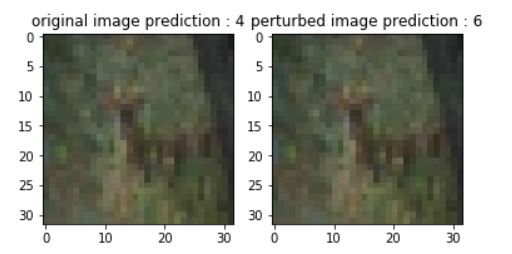DeepFool 알고리즘을 텐서플로우 1.X를 이용해서 구현해보았다.
코드는 https://github.com/LTS4/universal를 참조했다.
(저기에 있는 코드를 거의 그대로 따라했다.)
필요한 모듈 import
from keras.datasets import cifar10
import tensorflow as tf
from tensorflow.keras.layers import Flatten
import numpy as np
from keras.utils import to_categorical
from sklearn.utils import shuffle
import os
import matplotlib.pyplot as plt
Lenet 구현
데이터 전처리
def pre_data():
(x_train, y_train), (x_test, y_test) = cifar10.load_data()
x_train = x_train / 255.
x_test = x_test / 255.
y_train = to_categorical(y_train, 10,dtype='float32')
y_test = to_categorical(y_test, 10,dtype='float32')
return x_train, y_train, x_test, y_test
Classifier 생성
def init_weight(shape):
w = tf.truncated_normal(shape = shape, stddev = 0.1)
return tf.Variable(w)
def init_bias(shape):
b = tf.zeros(shape)
return tf.Variable(b)
def CNN_classifier(x):
conv1_w = init_weight((5,5,3,64))
conv1_b = init_bias(64)
conv1 = tf.nn.conv2d(x,conv1_w, strides = [1,1,1,1], padding = 'SAME') + conv1_b
conv1 = tf.nn.relu(conv1)
conv1 = tf.nn.max_pool2d(conv1,ksize = [1,2,2,1], strides = [1,2,2,1], padding = 'SAME')
conv2_w = init_weight((5,5,64,64))
conv2_b = init_bias(64)
conv2 = tf.nn.conv2d(conv1,conv2_w, strides = [1,1,1,1], padding = "SAME") + conv2_b
conv2 = tf.nn.relu(conv2)
conv2 = tf.nn.max_pool2d(conv2, ksize = [1,2,2,1], strides = [1,2,2,1], padding = "SAME")
conv3_w = init_weight((5,5,64,64))
conv3_b = init_bias(64)
conv3 = tf.nn.conv2d(conv2,conv3_w, strides = [1,1,1,1], padding = "SAME") + conv3_b
conv3 = tf.nn.relu(conv3)
conv3 = tf.nn.max_pool2d(conv3, ksize = [1,2,2,1], strides = [1,2,2,1], padding = "SAME")
fc0 = Flatten()(conv3)
fc1_w = init_weight((1024,120))
fc1_b = init_bias(120)
fc1 = tf.matmul(fc0,fc1_w) + fc1_b
fc1 = tf.nn.relu(fc1)
fc2_w = init_weight((120,84))
fc2_b = init_bias(84)
fc2 = tf.matmul(fc1,fc2_w) + fc2_b
fc2 = tf.nn.relu(fc2)
fc3_w = init_weight((84,10))
fc3_b = init_bias(10)
fc3 = tf.add(tf.matmul(fc2,fc3_w),fc3_b, name = 'last_layer')
output = tf.nn.softmax(fc3, name = 'logits')
return output
x_train, y_train, x_test, y_test = pre_data()
x_train, y_train = shuffle(x_train, y_train)
EPOCHS = 15
BATCH_SIZE = 128
x = tf.placeholder(tf.float32, (None,32,32,3), name = 'x')
y = tf.placeholder(tf.float32, (None,10), name = 'y')
logits = CNN_classifier(x)
loss_operation = tf.reduce_mean(-tf.reduce_sum(y * tf.log(logits), 1))
train_operation = tf.train.AdamOptimizer(1e-3).minimize(loss_operation)
correct_prediction = tf.equal(tf.argmax(logits, axis = 1),tf.argmax(y, axis =1), name = 'correct_prediction')
accuracy_operation = tf.reduce_mean(tf.cast(correct_prediction, tf.float32), name = 'accuracy_operation')
saver = tf.train.Saver()
Classifier 훈련
persisted_sess = tf.Session()
print (tf.global_variables())
persisted_sess.run(tf.global_variables_initializer())
num_examples = len(x_train)
print('Training...')
for i in range(EPOCHS):
x_train, y_train = shuffle(x_train, y_train)
for offset in range(0,num_examples,BATCH_SIZE):
batch_x = x_train[offset:offset+BATCH_SIZE]
batch_y = y_train[offset:offset+BATCH_SIZE]
persisted_sess.run(train_operation, feed_dict = {x : batch_x, y: batch_y})
train_accuracy = persisted_sess.run(accuracy_operation, feed_dict = { x : batch_x, y: batch_y})
print ("EPOCH {}...".format(i+1))
print ("Training Accuracy = {:.3f}".format(train_accuracy))
saver.save(persisted_sess,'CNN_classifier')
print ("Model Saved")
persisted_sess.close()
Classifier 평가
def evaluate(x_data, y_data):
num_examples = len(x_data)
total_accuracy = 0
for offset in range(0,num_examples,BATCH_SIZE):
batch_x, batch_y = x_test[offset:offset + BATCH_SIZE] , y_test[offset : offset + BATCH_SIZE]
accuracy = sess.run(accuracy_operation, feed_dict = { x : batch_x, y : batch_y})
total_accuracy += accuracy * len(batch_x)
return total_accuracy / num_examples
with tf.Session() as sess:
saver = tf.train.import_meta_graph('CNN_classifier.meta')
saver.restore(sess, tf.train.latest_checkpoint('.'))
test_accuracy = evaluate(x_test,y_test)
print ("Test Accuracy : {}".format(test_accuracy))
DeepFool 구현
tf.reset_default_graph()
sess = tf.Session()
saver = tf.train.import_meta_graph('CNN_classifier.meta')
saver.restore(sess, tf.train.latest_checkpoint('.'))
num_classes = 10
def jacobian(y_flat,input_image,inds):
grads = []
for i in range(num_classes):
grad = tf.gradients(y_flat[inds[i]],input_image)
grads.append(grad)
return grads
last_layer = tf.get_default_graph().get_tensor_by_name("last_layer:0")
last_layer_flat = tf.reshape(last_layer, (-1,))
inds = tf.placeholder(tf.int32, (num_classes,))
x = tf.get_default_graph().get_tensor_by_name("x:0")
dydx = jacobian(last_layer_flat,x,inds)
def f(image):
f_i = sess.run(last_layer, feed_dict = { x : image})
return f_i
def grad_fs(image, idx):
grads = sess.run(dydx, feed_dict = {x:image, inds : idx})
grads = np.array(grads)
grads = grads.squeeze(axis = 1)
return grads
def DeepFool(image, f, grad_fs, num_classes = 10, overshoot = 0.02, max_iter = 50):
f_image = f(image).flatten()
I = f_image.argsort()[::-1]
I = I[:num_classes]
label = I[0]
pert_image = image
f_i = f(pert_image).flatten()
k_i = int(np.argmax(f_i))
w = np.zeros(image.shape)
r_tot = np.zeros(image.shape)
loop_i = 0
while k_i == label and loop_i < max_iter:
pert = np.inf
gradients = grad_fs(pert_image, I)
for k in range(1,num_classes):
w_k = gradients[k,:,:,:,:] - gradients[0,:,:,:]
f_k = f_i[I[k]] - f_i[I[0]]
pert_k = abs(f_k) / np.sqrt(np.sum(w_k * w_k))
#pert_k = abs(f_k) / np.linalg.norm(w_k.flatten(),2)
if pert_k < pert:
pert = pert_k
w = w_k
r_i = pert * w / np.sqrt(np.sum(w_k*w_k))
# r_i = pert * w / np.linalg.norm(w_k.flatten(),2)
r_tot = r_tot + r_i
pert_image = image + (1+overshoot) * r_tot
f_i = f(pert_image).flatten()
k_i = int(np.argmax(f_i))
loop_i = loop_i + 1
r_tot = (1+overshoot) * r_tot
return r_tot, loop_i, k_i, pert_image
DeepFool 적용
(x_train, y_train), (x_test, y_test) = cifar10.load_data()
image = x_train[10]
c_ans = y_train[10]
image = np.array(image)
image = image /255.
image = image.reshape(1,32,32,3)
r_tot, loop_i, k_i, pert_image = DeepFool(image,f,grad_fs)
fig = plt.figure()
orig_pred = np.argmax(f(image))
deepfool_pred = np.argmax(f(pert_image))
ax1 = fig.add_subplot(1, 2, 1)
ax1.imshow(image.reshape(32,32,3))
ax1.set_title('original image ' + 'prediction : ' + str(orig_pred))
ax2 = fig.add_subplot(1, 2, 2)
ax2.imshow(pert_image.reshape(32,32,3))
ax2.set_title('perturbed image '+ 'prediction : ' + str(deepfool_pred))
plt.show()
